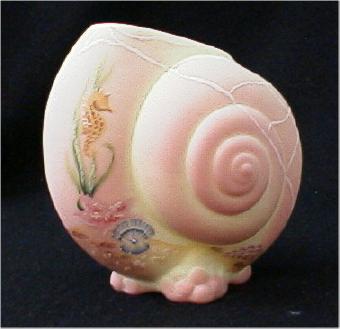A Fenton-Cambridge Connection
by David Adams
Issue No. 397 - June/July 2006
Last August, the glass world lost one of its treasures - Frank
Fenton passed away just a few weeks after Fenton Art Glass Company
celebrated its 100th year. Frank was one of the most knowledgeable
people in the field of glassware, and he was extremely generous in
sharing his knowledge with us all. Under Frank's direction, Fenton
acquired the records of the old  National Glass Combine, and many of the old
Butler Brothers catalogs, along with countless other paper records from
defunct glass companies. The library of documentation that he
accumulated is now being scanned and preserved for future generations
on CDs.
National Glass Combine, and many of the old
Butler Brothers catalogs, along with countless other paper records from
defunct glass companies. The library of documentation that he
accumulated is now being scanned and preserved for future generations
on CDs.
Those who met Frank discovered that he had a great sense of curiosity and he loved to explore the designs of items made of glass. He had an "idea room" at the Fenton factory, where there were hundreds of pieces of glass, none of which were Fenton. Frank bought items that he liked that were done by other companies, and saved them in the "idea room." Every once in a while, he would go into the room, pull a piece and take it to the mold shop. He would explain how he would like them to create a similar piece, but to change this or that in a way that would make it better (and not just a simple copy of another company's work).
When Imperial Glass Company went out of business, they called Frank and asked if he had any interest in some of their mold inventory. Frank purchased a number of molds from Imperial, and stored them away in the Fenton factory for future use. Most often, if he wanted to use a mold from another company, he would have it modified. You may have seen the Fenton-produced "Caprice" style vases, modified to have a ribbon around the neck of the vase. That was an original Cambridge mold, modified by Fenton to include the ribbon. And it can't be mistaken for an original Cambridge piece.
 Fenton also uses molds without any major
modifications. An example of this is the "Rams Head" single
candlestick, another Cambridge mold acquired at the time Imperial
closed down. In this case, there is a modification - each candlestick
has the Fenton mark molded into the underside, but beyond that is the
pledge from Fenton that they will never manufacture an item from
another company's mold in any color originally made by the original
company. You can find that "Rams Head" candlestick in a whole bunch of
neat colors, but nothing like any originally produced by Cambridge.
Fenton also uses molds without any major
modifications. An example of this is the "Rams Head" single
candlestick, another Cambridge mold acquired at the time Imperial
closed down. In this case, there is a modification - each candlestick
has the Fenton mark molded into the underside, but beyond that is the
pledge from Fenton that they will never manufacture an item from
another company's mold in any color originally made by the original
company. You can find that "Rams Head" candlestick in a whole bunch of
neat colors, but nothing like any originally produced by Cambridge.
Which brings us to the real reason that I wrote this article. The photograph at right shows a #46 "Snail" shaped vase from an original Cambridge mold that was acquired by Fenton when Imperial closed. To my knowledge, this is the first piece Fenton has made from that mold (I could be wrong here). The vase is done in Fenton's "Burmese" color, and hand painted and decorated. The significant thing is that it is signed on the underside:
- "Frank Fenton Memorial - 1915 - 2005"
and hand-numbered. There were only 1950 of these vases produced; each is numbered.
It is a beautiful piece of glass, and a fitting tribute to a man who was a friend to everyone he met, was an enthusiastic collector of glass, was willing to share his experiences and his expertise with all glass collectors, and someone who appreciated the beautiful creations of glass artists employed by his competitors.
Linda and I will miss Frank Fenton, as will many collectors who knew him. The vase is a wonderful way to keep his memory alive. The fact that it came from a Cambridge design makes it even more special.
